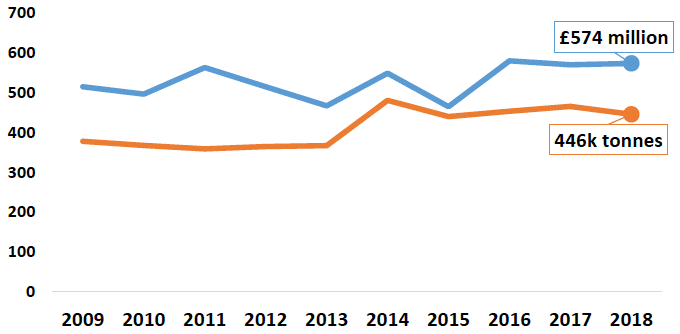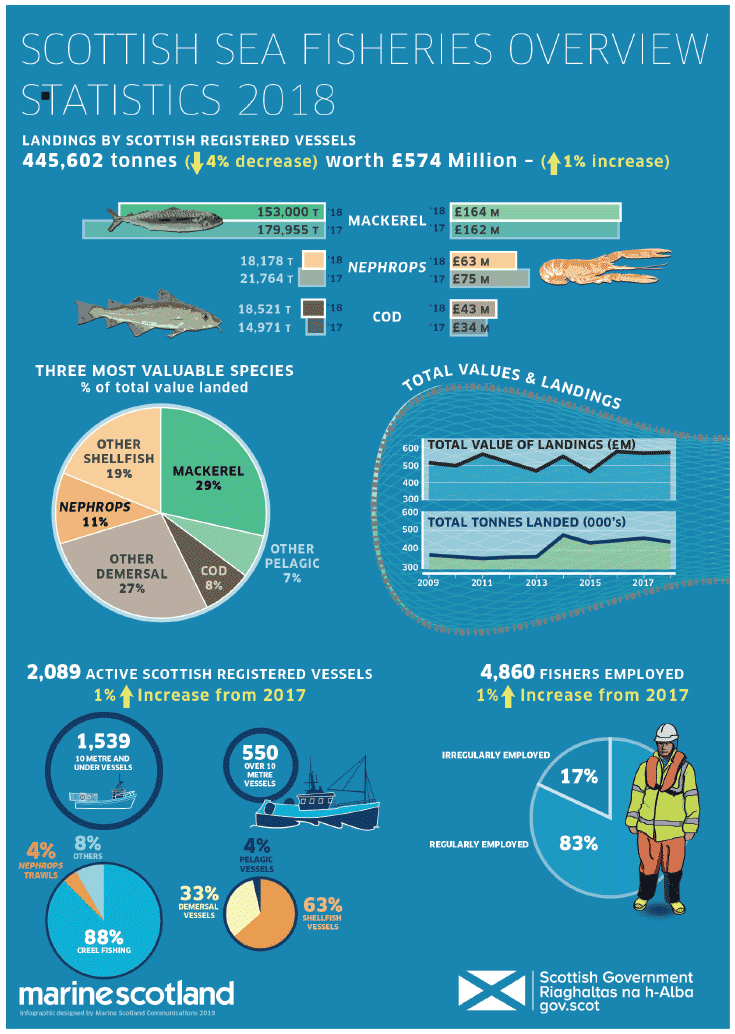Scottish sea fisheries statistics 2018
Tonnage and value of all landings of sea fish and shellfish by Scottish vessels, all landings into Scotland, the rest of the UK and abroad, and the size and structure of the Scottish fishing fleet and employment on Scottish vessels.
This document is part of a collection
2. Overview Statistics
2.1. Landings by Scottish vessels
In 2018, Scottish vessels landed 446 thousand tonnes of sea fish and shellfish with a gross value of £574 million. Compared to 2017 there was a small change in the real value of landings (one per cent increase) and a four per cent decrease in the tonnage landed.
The increase in value was driven by demersal species, as shellfish species decreased in value. Pelagic species were worth £202 million consistent with 2017. Demersal species increased seven per cent in value to £201 million. Shellfish value fell six per cent to £171 million.
Landings by Scottish vessels accounted for 58 per cent of the value and 64 per cent of the tonnage of all landings by UK vessels in 2018 (Table 22). Compared to 2017, the Scottish share of the total UK value has increased by one percentage point and tonnage has remained more-or-less unchanged (less than one percentage point change).
Mackerel remained the most valuable species landed by the Scottish fleet, representing 29 per cent of the value of all Scottish vessels' landings. Nephrops is the second most valuable species, with 11 per cent of the total value. Cod became the most valuable demersal species overtaking haddock with monkfish third. Together, cod, haddock and monkfish account for 22 per cent of the value of Scottish vessels' landings.
As shown in Chart 1, the general trend in the tonnage and value of landings over the past ten years is positive; tonnage has increased by 68,000 tonnes (18 per cent) and value in real terms has increased by £59 million (11 per cent) since 2009.
Chart 1. Total tonnage and value (adjusted to 2018 prices) of all landings by Scottish vessels, 2009 to 2018

2.1. The Scottish fishing fleet
There were 2,089 active Scottish fishing vessels in 2018, an increase of 24 vessels (one per cent) from 2017. In 2018, the number of over ten metre vessels was 550, down 12 vessels (two per cent) from 2017. The over ten metre demersal sector consisted of 184 vessels (no change), while the pelagic sector decreased by one to 19 vessels. The number of over 10 metre vessels in the shellfish sector decreased by 11 to 347 vessels.
There were 1,539 vessels in the ten metre and under fleet, an increase of 36 vessels (two per cent) compared to 2017. Creel fishing dominated the whole Scottish fleet with 1,347 vessels (65 per cent of the whole fleet, 88 per cent of the ten metre and under fleet). Vessel statistics by fishing method and length group are presented in Table 40.
2.2. Employment
There were 4,860 fishers employed on Scottish registered vessels at the end of 2018. This figure is up one per cent (61 fishers) since 2017. Compared to 2017, there were 100 more regularly employed fishers (three per cent increase), 41 fewer irregularly employed fishers (five per cent decrease) and two more crofters. Low numbers of crofters may represent difficulties in classifying which fishers are crofters.
Figure 1. Overview Statistics Infographic

Contact
Email: Cameron.Melvin@gov.scot
There is a problem
Thanks for your feedback